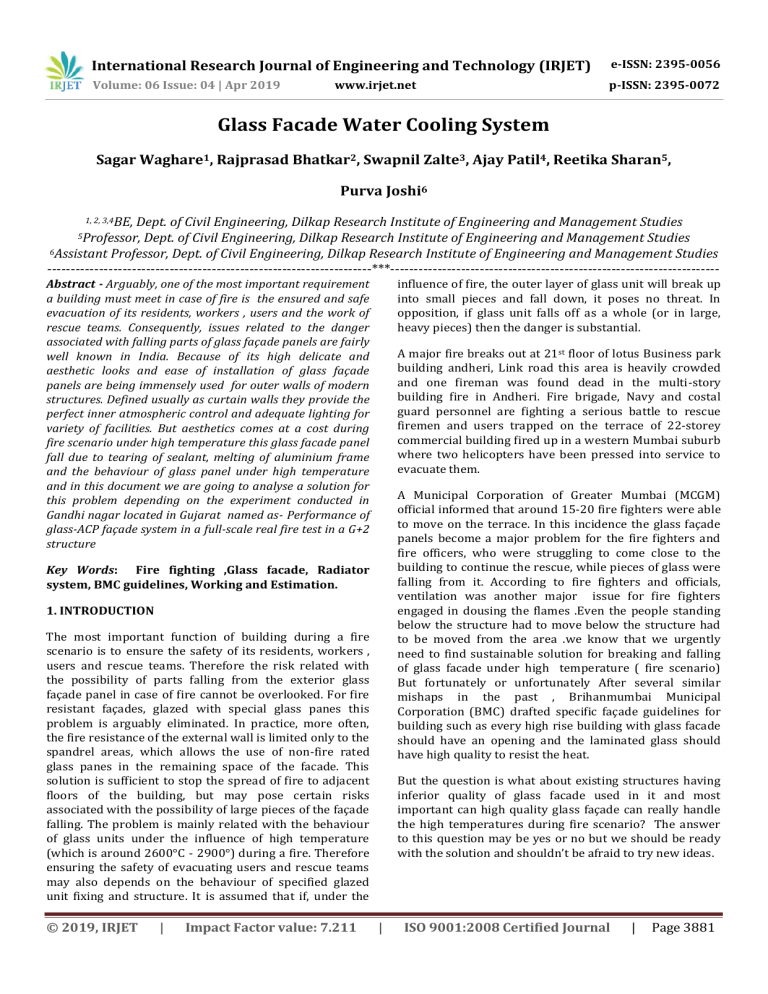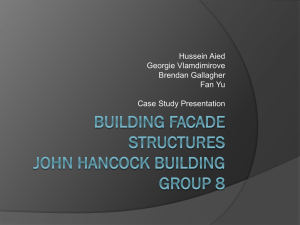IRJET- Glass Facade Water Cooling System
advertisement

International Research Journal of Engineering and Technology (IRJET)
e-ISSN: 2395-0056
Volume: 06 Issue: 04 | Apr 2019
p-ISSN: 2395-0072
www.irjet.net
Glass Facade Water Cooling System
Sagar Waghare1, Rajprasad Bhatkar2, Swapnil Zalte3, Ajay Patil4, Reetika Sharan5,
Purva Joshi6
1, 2, 3,4BE,
Dept. of Civil Engineering, Dilkap Research Institute of Engineering and Management Studies
Dept. of Civil Engineering, Dilkap Research Institute of Engineering and Management Studies
6Assistant Professor, Dept. of Civil Engineering, Dilkap Research Institute of Engineering and Management Studies
---------------------------------------------------------------------***---------------------------------------------------------------------5Professor,
Abstract - Arguably, one of the most important requirement
a building must meet in case of fire is the ensured and safe
evacuation of its residents, workers , users and the work of
rescue teams. Consequently, issues related to the danger
associated with falling parts of glass façade panels are fairly
well known in India. Because of its high delicate and
aesthetic looks and ease of installation of glass façade
panels are being immensely used for outer walls of modern
structures. Defined usually as curtain walls they provide the
perfect inner atmospheric control and adequate lighting for
variety of facilities. But aesthetics comes at a cost during
fire scenario under high temperature this glass facade panel
fall due to tearing of sealant, melting of aluminium frame
and the behaviour of glass panel under high temperature
and in this document we are going to analyse a solution for
this problem depending on the experiment conducted in
Gandhi nagar located in Gujarat named as- Performance of
glass-ACP façade system in a full-scale real fire test in a G+2
structure
influence of fire, the outer layer of glass unit will break up
into small pieces and fall down, it poses no threat. In
opposition, if glass unit falls off as a whole (or in large,
heavy pieces) then the danger is substantial.
A major fire breaks out at 21st floor of lotus Business park
building andheri, Link road this area is heavily crowded
and one fireman was found dead in the multi-story
building fire in Andheri. Fire brigade, Navy and costal
guard personnel are fighting a serious battle to rescue
firemen and users trapped on the terrace of 22-storey
commercial building fired up in a western Mumbai suburb
where two helicopters have been pressed into service to
evacuate them.
A Municipal Corporation of Greater Mumbai (MCGM)
official informed that around 15-20 fire fighters were able
to move on the terrace. In this incidence the glass façade
panels become a major problem for the fire fighters and
fire officers, who were struggling to come close to the
building to continue the rescue, while pieces of glass were
falling from it. According to fire fighters and officials,
ventilation was another major issue for fire fighters
engaged in dousing the flames .Even the people standing
below the structure had to move below the structure had
to be moved from the area .we know that we urgently
need to find sustainable solution for breaking and falling
of glass facade under high temperature ( fire scenario)
But fortunately or unfortunately After several similar
mishaps in the past , Brihanmumbai Municipal
Corporation (BMC) drafted specific façade guidelines for
building such as every high rise building with glass facade
should have an opening and the laminated glass should
have high quality to resist the heat.
Key Words: Fire fighting ,Glass facade, Radiator
system, BMC guidelines, Working and Estimation.
1. INTRODUCTION
The most important function of building during a fire
scenario is to ensure the safety of its residents, workers ,
users and rescue teams. Therefore the risk related with
the possibility of parts falling from the exterior glass
façade panel in case of fire cannot be overlooked. For fire
resistant façades, glazed with special glass panes this
problem is arguably eliminated. In practice, more often,
the fire resistance of the external wall is limited only to the
spandrel areas, which allows the use of non-fire rated
glass panes in the remaining space of the facade. This
solution is sufficient to stop the spread of fire to adjacent
floors of the building, but may pose certain risks
associated with the possibility of large pieces of the façade
falling. The problem is mainly related with the behaviour
of glass units under the influence of high temperature
(which is around 2600°C - 2900°) during a fire. Therefore
ensuring the safety of evacuating users and rescue teams
may also depends on the behaviour of specified glazed
unit fixing and structure. It is assumed that if, under the
© 2019, IRJET
|
Impact Factor value: 7.211
But the question is what about existing structures having
inferior quality of glass facade used in it and most
important can high quality glass façade can really handle
the high temperatures during fire scenario? The answer
to this question may be yes or no but we should be ready
with the solution and shouldn’t be afraid to try new ideas.
|
ISO 9001:2008 Certified Journal
|
Page 3881
International Research Journal of Engineering and Technology (IRJET)
e-ISSN: 2395-0056
Volume: 06 Issue: 04 | Apr 2019
p-ISSN: 2395-0072
www.irjet.net
raw of glass façade panels evenly with the help of
distribution pipes.
1.1 Basic mechanism:
this system is based on water radiator used in automotive
engines in which water circulates from the engine to the
radiator, a system of fins and tubes with a lot of exterior
surface area heat moves from the hot water to the radiator
, causing the water to cool off in this way ,the engine heat
moves out of the cooling system and into the surrounding
air in case of building having glass façade we will use this
mechanism to cool the glass façade panels in which water
will work as a coolant and the glass façade will resemble
automotive engine.
2.
The water flowing over the glass panels keeps the
temperature of glass panels under control and acts as a
cooling agent in case of building with height less than 35
meters we can add polymers which are known to cover
more surface area effectively and good absorbent of heat.
3.
Then this water is collected near the bottom most
raw of the glass panels with the help of collecting pipe.
4.
Collected water from the collecting pipe is then
diverted towards the hydraulic pump having pressure
15bars-20bars.
5.
Collected water from the collecting pipe is then
diverted towards the hydraulic pump having pressure
15bars-20bars.
6.
This cycle is continued over and over again to
keep the temperature under control until the fire is fully
extinguished.
2. ESTIMATION
Technical Specification of equipments requires:
●
For this system will require a water tank or
separate water supply system which capacity depends on
the surface area of building consisting glass façade.
●
Hydraulics – this system will require a high
pressure water pump which can generate pressure upto
(15bars -20bars).
18M
●
Jockey pump – jockey pump will keep the system
pressurized during normal non-fire conditions. Since the
activation of the large flow main fire pump is triggered by
a system pressure drop. It is important to maintain system
pressure since even normal plumbing leaks allow the
system pressure to bleed down over a period of time.
When the system pressure drops to a present level, the
jockey pump starts and charges the system back to normal
pressure. Addition of jockey pump will depend on
application of dry rise system or wet rise system
26M
24M
Considering a building having a surface area covered by
glass façade panel :Total surface area covered by glass façade panel=864+936
●
Hose/Pipe system – For this system copper
pipes are recommended as they are good conductor of
heat and thus copper pipe will absorb the heat from the
water flowing over the glass panels and distribution pipes
= 1800Square Meter
1. Volume of water required to cover the entire area of
glass façade panels-
1.2 Working-
=NO. OF SIDES* SURFACE AREA* THICKNESS
1.
In this system in the case of fire scenario the
information regarding the location of fire and its class
gathered with the help of smoke detectors and the water
from the overhead tank is allowed to fall over the top most
= {2*(18*24)*0.05} + {2*(18*26)*0.05}
© 2019, IRJET
|
Impact Factor value: 7.211
= 90 m^3
|
ISO 9001:2008 Certified Journal
|
Page 3882
International Research Journal of Engineering and Technology (IRJET)
e-ISSN: 2395-0056
Volume: 06 Issue: 04 | Apr 2019
p-ISSN: 2395-0072
www.irjet.net
Total Volume Of Water sliding Over Glass Facade
Panel=90000 liters
= 565 liters
3)
2. PUMP SPECIFICATION:
No. of pumps = 2
Hp = 170 H
3800
Spec. gravity of water = 800 kg/m3
Volume of water = 0.893 m2/s
RPM =
Rel =(U×L)/V
Impeller Diameter of pump = 280 mm.
= (7.388×10-3×18)/ 0.893
vane angle = 30 , impeller diameter = 280 mm, outer
width =50 mm, manometric efficiency =95%
⮚
(Frictional losses in pipe = 0.083 m)
= 0.0148
CD =1.328/
Hm = 18m
N =3800rpm
= 1.328/
Vane angle = 30
= 10.91
FD = 0.5 ×ρ×A ×V2×CD
D2 = 280 mm
= 0.5×800×18×100×(7.388×10-4)2
B2 = 50 mm
Efficiency =95% =0.95
FD = 4.28 N
1) Tangential velocity of impeller at outlet
Friction Drag = 4.28 N
4)
Assuming the water quantity required to cover
the glass façade panel = 90000 lit
= (π×0.28×3800) /60
+ water held by copper pipe = 565 liter
=55.76 m/s
+ (frictional losses in pipe + water flowing over glass plate
) = (0.083+4.28)
2) Ƞman =(g×Hm) / (Vw2×U2)
0.95 = (9.81×18) / (Vw2×55.71)
Therefore, Providing = 95000 lit. Water Tank
considering all the losses & Cavication of Centrifugal pump
Vw2 = 3.33 m/s
2)
3. CONCLUSIONS
tan ø =Vh2 / (U2 –Vw2)
tan 30
As we have discussed earlier Brihanmumbai Municipal
Corporation (BMC) drafted specific façade guidelines for
building such as every high rise building with glass facade
should have an opening and the laminated glass should
have high quality to resist the heat.
= Vh2 /(55.71-3.33)
Vh2 =30.24 m/s
Discharge = Q = π×D2B2×Vf2
But the question is what about existing structures having
inferior quality of glass facade used in it and most
important can high quality glass façade can really handle
the high temperatures during fire scenario? The answer
to this question may be yes or no but we should be ready
with the solution and shouldn’t be afraid to try new ideas .
and this is small innovation from our side which can cool
the glass façade panel under high temperature during fire
scenario for safe evacuation and mainly focuses on the
existing structures having glass façade panels which are
not ready to replace whole glass façade system with new
= π×0.28×0.05×30.24
Q = 1.33 m3/s =1330liter/sec
Copper PipeVolume of water held by the copper pipe = π r h
(ø =20 cm) = π × (0.2/2)2 ×18
= 0.565 m3
© 2019, IRJET
|
Impact Factor value: 7.211
|
ISO 9001:2008 Certified Journal
|
Page 3883
International Research Journal of Engineering and Technology (IRJET)
e-ISSN: 2395-0056
Volume: 06 Issue: 04 | Apr 2019
p-ISSN: 2395-0072
www.irjet.net
high resisting glasses, Further improvements in this
system can be done by addition of fast heat absorbing and
releasing material in circulating water.
REFERENCES1.
Performance of glass-ACP façade system in a fullscale real fire test in a G+2 structure, by
andhi 2017
2.
Andheri tower blaze (19 july 2014, 07:44) article
by https://www.indiatoday.in
3.
IniaMart
(manufacturers,
specifications.
4.
Mechanism principleof radiator used in
automotives
https://www.dieselserviceandsupply.com/Gener
ator_Cooling_Systems.aspx
5.
Fluid mechanics and hydraulic machines by
Dr.R.K.Bansal , Laxmi publications (P) LTD Ninth
edition.
6.
Guidelines on use of glass in building-Human
safety. www.ccpsindia.com -Third Edition : March
2013
© 2019, IRJET
|
https://www.indiamart.comsuppliers, exporters) pump
Impact Factor value: 7.211
|
ISO 9001:2008 Certified Journal
|
Page 3884


